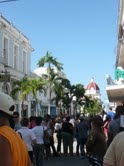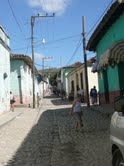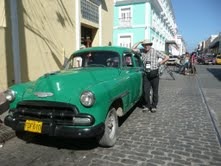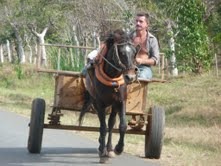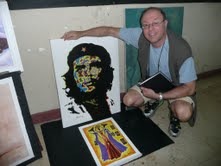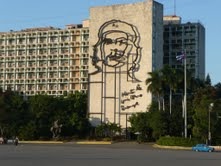My wife and I traveled to Cuba with 22 other Americans (January 9-16) on a tour organized by Road Scholar; a Boston based nonprofit travel agency formerly known as Elderhostel. Road Scholar has a license issued by the Office of Foreign Assets Control of the U.S. Treasury Department to conduct People-to-People interactions.
The trip—Shalom Cuba: Exploring Jewish Heritage—is a cultural exchange that is permitted by the federal government despite the official embargo that has been in effect for more than 50 years.
The trip began with an orientation session in Miami on January 8th led by a Venezuelan born American former software engineer who gave us an overview of tourist expectations and other key information to make our trip enjoyable.
After Geraldine gave her presentation we heard from Annie Betancourt director of the Florida League of Women Voters. A Cuban-American who came to Florida at age 13 in 1960 she has served in the Florida state legislature and was an unsuccessful Democratic candidate for the House of Representatives. Annie gave us an overview of Cuban-American relationships since the January 1, 1959 Revolution and its impact on American politics, between the proponents of lifting the embargo and hardline politicians including New Jersey’s Senator Bob Menendez.
On January 9 we took an early morning one-hour charter flight from Miami International Airport to Cienfuegos, a port city of about 100,000 in the southern central part on the island. In addition to our group dozens of Cuban Americans were on board to visit their families. Upon landing, we went through immigration control. We handed one-half of our visa to the agent and had our picture taken. The other half would be surrendered when we would leave the country when our picture would be taken again. We also had to pay an exit tax of 25 CUCs (pronounced cooks), per person, the convertible currency for tourists. The exchange rate is 1:1 but there is a 10% tax on U.S. dollars plus a commission, so we received only .87 CUCs per dollar.
While waiting for our luggage, the carousel looked like Amazon’s shipping department. Every imaginable consumer good passed by, big screen TVs, clothing, toys, etc. Cuban Americans in effect have become one of the island’s largest “foreign aid” donors.
At the small Cienfuegos airport, virtually all the women employees were wearing highly stylized mesh stockings. You could not help but notice the stockings. They were a bold contrast to the drab green/beige uniform.
After going through the terminal we met our local bilingual guide (Hector) and bus driver and made our way to a brand new Chinese manufactured A/C bus. The bus had a Hyundai symbol on the front dash, so it could have been assembled in the Korean company’s plant in China. We did not ask the guide about it.
We were taken to the center of Cienfuegos to walk through the main shopping district. The street was full of people (who were dressed adequately but nothing fancy) at 1pm on a Wednesday and there was no trash on any of the streets.
Usually, in poor countries sanitation leaves much to be desired but in Cienfuegos and other cities we visited there was virtually no street trash. The best explanation for this is that there is a shortage of paper goods in Cuba. People bring their own (usually plastic) bags to the marketplace.
We stopped by a few stores to see the type of goods available to Cubans, all priced in local pesos. For Cubans, every good seems to be very expensive relative to their meager incomes.
Another obvious impression that hit us as we were driving in from the airport and waking through Cienfuegos is that the outside of most buildings is run down; crumbling facades, peeling paint, rusting metal, etc. In other words, the housing stock is in relatively poor shape. That’s the bad news. The good news is that private ownership of housing is very high.
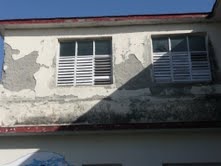
The roads in Cuba leave much to be desired. They are paved but heavily patched. Even the highways are bumpy. Taking notes on the bus was a challenge. In Trinidad, the streets look like a Hollywood set right out of the early 20th century.
Being Cuba is like being in a time warp. Most of the vehicles are from the 1950s, and my father’s first car, a used 1952 Plymouth he purchased from his cousin for $500 in 1956, was everywhere. Some of the vehicles were in good shape while others were painted with what looked like house paint.
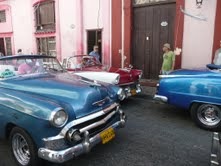
In addition, in the smaller towns, residents get around in bicycles and horse and buggies, especially in the countryside. After our brief tour of Cienfuegos, we went to our hotel for lunch. Bottled water is a must because the water pipes tend to break frequently and thus is not drinkable by our standards. Lunch was very good—fish or chicken and plenty of rice, beans, cabbage, and other vegetables. Rum and coke is almost a staple as is beer, and all were included in every lunch and dinner on the tour. In a couple of restaurants, the liquor was unlimited.
Pictures of Che Guevara are everywhere. Fidel Castro’s comrade in arms is a national hero, even though he was from Argentina, because of the role he played in overthrowing the Batista regime. Che tried to spread the Revolution to the rest of South America. Che and his comrades were killed (1967) in Bolivia where they tried to foment a revolt. ( I did not buy the Che artwork.)
At the Revolution Plaza in Havana where Fidel held his multi hour speeches, there is huge tribute to Che with the inscription, Always toward victory.
Next post: The Cuban economy
